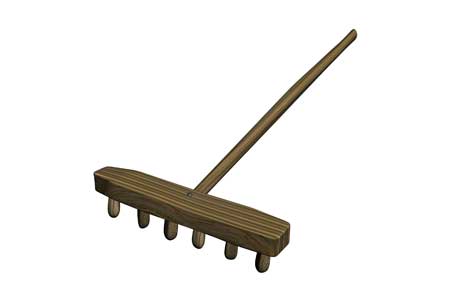
Above, the rascan was used for day to day maintenance and weeding of the crops.
It was constructed from scraps of wood, shaped and held together with pins. The wooden teeth would have needed regular replacement.
When the 18th century began, Scotland, like most of Europe, displayed all the characteristics of what would today be called an under-developed country. Nine out of ten people earned their living from the land, using methods virtually unaltered since the Middle Ages. The country's wealth was derived from the produce of the land, produced for the land owners by tenants. Farming was not for profit, but for subsistence. Tenants worked the land (e.g., plowing, sowing, reaping, threshing, milling) in teams, earning their own livelihood, and sustaining their lords through their rentals paid usually in the form of the produce. Tenants relied on landless labourers for their workforce.
Scottish peasantry were organized by social strata determined by their tenure and by their economic position in the farmtoun community. The peasants who held the tenancy or joint-tenancy of the farm were at the top of the hierarchy. Being a tenant didn't necessarily mean prosperity. A farm might be held by a dozen joint-tenants, each of whom farmed only small shares. However, in parts of the Lowlands, the tenant (often called the husbandman or gudeman) was the aristocrat of peasant life.
Below the tenant were the peasants he employed: the ploughmen, hinds (servants), herds (shepherds), and threshers. These positions may have been obliged to employ a labourer to assist in the tasks - wherever possible this would be the peasant's own son.
Below these were the crofters, cottars, and grassmen. These men were essentially tenants who had a hut, kailyard (kitchen garden), a small amount of arable land, and the right to graze a few animals on pastureland. All paid their rent primary by labour on the husbandman's farm. A crofter might have more animals and land to farm than the cottar. The grassman might be no more than a poor cottar with herding duties.
Boys usually found work on farms as ploughmen. Girls normally became domestic servants where the work was hard and the hours were long. A working day normally stretched to 15 hours and included tasks such as cleaning the kitchen, lighting fires, milking cows, feeding the men, churning milk for butter and cheese plus fetching and carrying all manner of things.
In the spring, most of the work was outdoors, as the ground had to be ploughed, the ground harrowed and the seeds planted. The farms could not have worked as well as they did without the power provided by the horses and the men who worked them so well. But it was a hard life and men grew old very quickly. Working in all weathers in wet clothes with few drying facilities in the cottars meant that only the toughest survived and were able to work into old age.
Generally, country shoemakers, weavers, and tailors (where these positions existed as separate occupations) were also cottars with a small holding of arable land.
Below these positions were the landless labourers and indoor farm servants, both men and women who received some wages in money and some in kind. They might be boarded in the husbandman's house (on straw pallets by the fireplace) or be 'out-servants.' Many were probably junior members of a crofter's family.
None of the peasants, from husbandman down to grassman, had a legal or hereditary right to the property they farmed. Husbandmen might have short leases from one to six years. If not, they were tenants-at-will like all of the other peasants. As such, they lived on the land from year to year, subject to the will of the landowner who in theory could evict them at short notice for no reason. In practice, landowners tended to leave tenants-at-will undisturbed so long as their husbandry was satisfactory. Changing tenants was costly for the landowner if only because the incumbent occupier possessed specialist knowledge of the idiosyncrasies of the farm's soil which would take a newcomer time to learn. This was especially true when there was a shortage of available labour. When evicted, any improvements that the peasant had made to the land (or to his cottage) became the property of the landowner.
The practice of passing tenancy onto one's children varied from one part of the country to another according to population pressures. In the highlands in the 18th century, it seems to have been the practice to provide every son with a fragment of land either as a tenant or a sub-tenant so far as possible. However, other locations might have a prohibition on the number of cottars a husbandman might have. In areas where such rules existed, population pressure among the peasantry would force younger sons to emigrate to the towns or to find jobs locally that didn't have land attached to them (e.g., farm labourer). Others became 'broken men', wandering beggars, or thieves. The alternative to uncontrolled transfers of tenancy wasn't much better. Small, fractionalized holding could not provide a family with even basic subsistence.
Peasant security was highest when there were no population pressures. For example, in the 17th century, increases in population were severely checked by outbreaks of disease and famine, especially in the 1690s.
Sources
Smout, T.C. (1998). A History of the Scottish People, Fontana Press.
Various web sites, including
Rural Life in the 18th Century (www.electricscotland.com/history/rural_lifendx.htm)
Scottishmist (www.scottishmist.com)